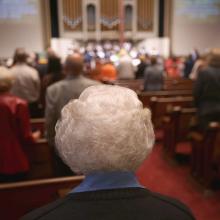church service
On Thursday, the Centers for Disease Control and Prevention (CDC) released updated guidelines telling people who have received the COVID-19 vaccine that they can now attend a full-capacity worship service and sing in an indoor chorus, among other activities.
While people “will still be required to wear a mask on planes, buses, trains, and other forms of public transportation” the CDC guidelines now say that if “you are fully vaccinated, you can resume activities that you did before the pandemic...without wearing a mask or physically distancing.”
No president should be allowed, without any justifiable warrant, to deny the free exercise of their religious convictions, especially when those actions serve not their own interests, but the displaced, suffering millions of strangers in the world longing for welcome.

Image via Atosan/Shutterstock
Skeptics might say that as a perimenopausal woman with a teenage daughter, I’m apt to cry at the slightest provocation, which may be true. But I believe something different happens when we expose our vulnerabilities in a community of faith.
A close friend told me her theory that we are being “seasoned” in church each week, preparing to be broken open in ways we cannot anticipate. So we pray the liturgy, sing the hymns, go through the motions. Yet this seasoning of our spirits prepares us to be tender-hearted, open to prayer working on us.
This makes sense to me. There are so few places where we can bring our raw emotions without a self-conscious need to explain or escape to the nearest bathroom, which happens when we get teary-eyed at work or in line at Home Depot. Perhaps church is one of those last safe havens, where we can cry in public for no reason.
A tech writer’s obituary for PCWorld’s print magazine — part tongue-in-cheek, part nostalgia riff — reminded me that I once devoured that magazine, now kaput.
It was an early lens into the fascinating world of personal computing. Its ads and articles stoked dreams of power and speed.
I soon became part of PCWorld’s dilemma. I dropped the print mag and began seeking tech news on the Internet. It was faster and fresher, had clickable links to other sites, great art, and brevity. PCWorld itself went online.
Much of my world has switched to the Internet. I do most of my banking and bill paying online, shop online, order lunch online, learn choir music online, teach classes online, use email and text messaging extensively, and read the news online.
Nothing unusual in any of that. Such web-centered behavior has become the new normal. Any enterprise that isn’t considering ways to move its operations online is losing its future.
In my world, more and more churches are going web. Electronic newsletters replace mailed paper. Clergy use email to communicate, as do staff and volunteers. Tweets, Facebook posts, e-blasts, and text messages carry word of emergencies. Constituents make donations online.
There’s more. Classes are moving online, as are interviews with job candidates and opinion surveys. Some congregations are experimenting with worship online and small groups. Every Sunday morning, some 600,000 people a minute access Bible verses online using one app.
I empathize with people fleeing the local church. Churches can be battlefields instead of harbors, pits of condemnation or politics rather than wells of living water.
But the endless search for something “new” has trumped the life-changing story the body of Christ has nurtured and passed on for 2,000 years. This transforming story is the story the churches enacted weekly in Word and Sacrament before they forgot their original vocation as shelters of truth, life, and light amidst lies, death, and darkness. There were four revealed ways Jesus was present at the center of their public gatherings. These ways have been lost in too many places but are waiting to be rediscovered. More on that in a moment.
A young woman, a house church attendee, told me she longs for solid pastoral guidance, a message prepared weekly by an authoritative teacher, for worship that places Jesus Christ at the exact center of a public space where everyone is welcome, a place where she can bring her disbelieving friends whose lives are not yet transformed by self-sacrificial Love, a place where they can speak openly and honestly about where their lives still remain isolated from a holy God, a place of worship that does not lean on any one person's (or her personal) understanding and articulation of the Gospel but on the collective wisdom of the body of Christ.



